#dharma chinese
Explore tagged Tumblr posts
Text
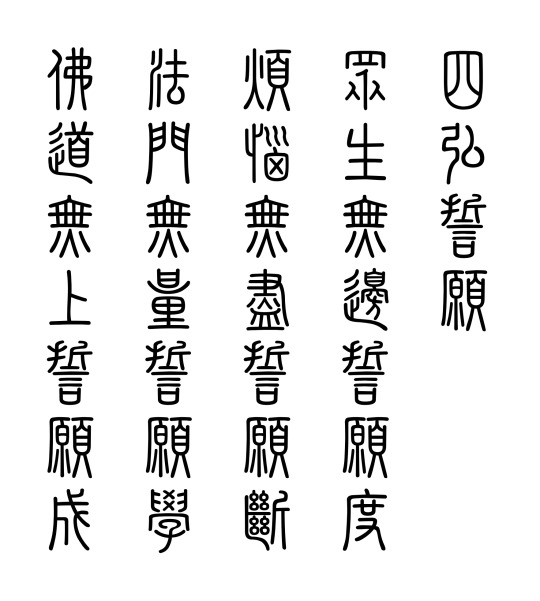
The Four Encompassing Vows Masses of creatures, without bounds, I vow to save. Anxiety and hate, delusive desires inexhaustible, I vow to break. Dharma gates beyond measure, I vow to learn. Buddha’s Way, unsurpassable, I vow to accomplish.
#bodhisattva#buddhism#mahayana#buddha#dharma#salvation#eschatology#teleology#nirvana#four noble truths#chinese#kanji#seal script
52 notes
·
View notes
Text
I reactivated this blog to talk about things that are too profound or dark maybe, to talk about them showing my face online. It’s too intense, I feel, and too vulnerable sometimes.
So here are the indicators that this is supposed to be a Very Difficult Year.
· Solar Return’s ascendant is in the 12th house
· My Sidereal Solar Return warns about this being a year of reaping karmic seeds I planted in the past. And that there’s a possibility of illness or injuries that require hospitalization. As well as themes of feeling very limited.
· The Lunar Nodes are currently in my 6th (Aries, natal Mars) and 12th (Libra, natal Sun & Mercury) respectively
· I am going through a 12th house profection year
· Tibetan astrology says everyone with Mewa 3 is going to experience their Very Difficult Year starting in February 2024 (lunar year) and we’re supposed to take care of our health more, which I already need to do because…
· I have a chronic illness. Pulmonary Hypertension, which affects heart and lungs, and I had a relapse back in September, from which I am still on the road to recovery
· I am a Dragon in chinese astrology, and all Dragons are experiencing their “Obstacle Year” starting February 2024.
· Feng Shui’s Tai Sui falls on Dragons this year.
This is not a fear mongering post to anyone that shares any of these things with me, and certainly I am not trying to be pessimistic. I have been dedicating myself to Dharma (Buddhism) practice and have been investing in purifying my karma, doing Medicine Buddha practices, and working on transforming my mind to be better able to handle everything that life throws my way.
So this is a Journal-like blog to document this year. To lean onto throughout this self-undoing year which might seem daunting and uncertain, but if I take it one day at a time, it might be less so.
Cheers to making it to the other side!
Lotus12h
2 notes
·
View notes
Text
youtube
Venerable Hong Ci is a Chinese-Canadian monk from Vancouver in the Chan (Chinese Zen) Tradition and in this lecture he explains what happiness really is.
#Buddhist Philosophy#Venerable Hong Ci i#Chan (Chinese Zen) Tradition#Dharma#Spiritual Warrior#Youtube
1 note
·
View note
Text
MERIAH !! MALAM TAHUN BARU IMLEK ~ PERAYAAN IMLEK ~ VIHARA DHARMA BAKTI PETAK SEMBILAN GLODOK. MERIAH !! MALAM TAHUN BARU IMLEK VIHARA DHARMA BAKTI PETAK SEMBILAN GLODOK ~ KELENTENG JIN DE YUAN. MERIAH !! MALAM TAHUN BARU IMLEK ~ PERAYAAN IMLEK ~ VIHARA DHARMA BAKTI PETAK SEMBILAN GLODOK.
youtube
#vihara dharma bakti#petak sembilan#petak 9#glodok#menyambut hari raya imlek 2024#rayakan kemenangan di tahun baru imlek#imlek#chinese new year#donniykhristanto#donniy_khristanto#youtube#youtuber#wonderful indonesia
1 note
·
View note
Text
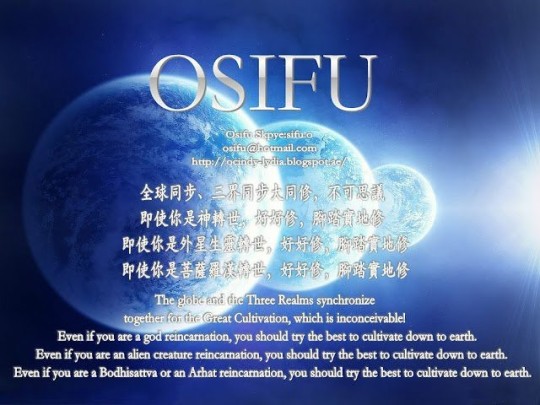
OSIFU 014. The time of global cultivation is coming.
For a translation of the Chinese of this post into English, visit
全球大同修的時代即將到來
大同修更是不可思議!
全球同步、三界同步大同修,不可思議!
《任逍遙》
--Osifu
命由自造,因緣果報
若是心迷,隨業受報。
若是心覺,隨緣逍遙。
2010-03-09 10:24:03,題贈弟子有緣人參悟。
如果我的弟子去做大俠,除暴安良、劫富濟貧,打抱不平。
Osifu會怎麼想?
佛菩薩會怎麼看?
護法神會怎麼辦?
《真慈悲》
--Osifu
莫說佛子不慈悲,
因緣果報如影隨。
透過因果看是非,
無我度人真慈悲。
2010-03-09 11:12:58,題贈弟子有緣人參悟。
真和諧!
真和氣!
真和美!
真和善!
真和睦!
真和樂!
真和合!
--Osifu
本是同心圓,
如星繞日轉。
平衡任自然,
祥和宇宙間。
2010-03-09 12:01:29,題贈弟子有緣人參悟。
《無需躲》
--Osifu
清靜身口意
莫論禍與福
爾若心地淨
災劫無需躲。
2010-03-09 12:43:50,題贈弟子有緣人參悟。
2010-03-09 晚上Osifu開示
每天Osifu 都要抽空看一看圓滿閣群聊天記錄。
看到大家的成長,是Osifu最開心的事。
這正是佛菩薩、護法神、Osifu、眾生希望看到的。
“迷時師度 悟時自度”!
成佛之路,要靠自己一步一步、腳踏實地、實修親證。
成佛之路,來不得心浮氣躁。
成佛之路,來不得心高氣傲。
成佛之路,來不得恃才傲物。
成佛之路,來不得貪嗔癡慢。
成佛之路,來不得分別妄求。
成佛之路,來不得我執當頭。
成佛之路,來不得法執胡謅。
成佛之路,來不得投機取巧。
成佛之路,來不得違背規律。
成佛之路,來不得逆反法則。
即使你是神轉世,好好修,腳踏實地修。
即使你是仙轉世,好好修,腳踏實地修。
即使你是外星生靈轉世,好好修,腳踏實地修。
即使你是菩薩羅漢轉世,好好修,腳踏實地修。
即使你是阿修羅轉世,好好修,腳踏實地修。
即使你是人轉世,好好修,腳踏實地修。
即使你是三惡道轉世,好好修,腳踏實地修。
即使你是多維生靈轉世,好好修,腳踏實地修。
披一張人皮,太不容易!
紅塵一路,太不容易!
娑婆五濁,太不容易!
應劫而生,太不容易!
脫胎換骨,太不容易!
天人合一,太不容易!
圓滿使命,太不容易!
金身正果,太不容易!
同心回歸,太不容易!
你登上人間大舞台,你準備怎麼演好你的角色?
你登上天地大舞台,你準備怎麼演好你的角色?
你登上普度大舞台,你準備怎麼演好你的角色?
你登上三界大舞台,你準備怎麼演好你的角色?
你登上大同脩大舞台,你準備怎麼演好你的角色?
你登上大回歸大舞台,你準備怎麼演好你的角色?
這一切的一切,只是一場夢,��是卻由我們演繹。
這一切的一切,只是一個傳說,可是卻由我們演繹。
這一切的一切,只是一段神話,可是卻由我們演繹。
這一切的一切,只是一個傳奇,可是卻由我們演繹。
這一切的一切,只是一朵浪花,可是卻由我們演繹。
這一切的一切,只是一段樂章,可是卻由我們演繹。
這一切的一切,只是一個心跳,可是卻由我們演繹。
這一切的一切,只是一個脈衝,可是卻由我們演繹。
這一切的一切,只是一篇新紀,可是卻由我們演繹。
這一切的一切,如此得虛假而又真實;
這一切的一切,如此得乏味而又豐富;
這一切的一切,如此得單一而又多姿;
這一切的一切,如此得混沌而又妙明;
這一切的一切,如此得污濁而又清淨;
這一切的一切,如此得煩惱而又菩提;
這是宇宙的遊戲,一切本來都是虛擬。
這是自然的遊戲,一切本來都是虛擬。
這是人體的遊戲,一切本來都是虛擬。
(The era of global fellow practitioners is coming)
0 notes
Text

0 notes
Text
⚠️ I am not chinese, so if any chinese person in the fandom wants to add something or just point out any mistake, please do ⚠️
I've seen people in the fandom call Macaque's smoke monster 'kaiju', but this is not a correct denomination.
It is better to call it "法相" (fa3 xiang4), meaning "image of (commonly Buddha)"
"佛教术语,指诸法之相状,包含体相(本质)与义相(意义)二者"
Trans.
"A Buddhist term that refers to the appearance of all dharmas, including both physical appearance (essence) and righteousness (significance)"
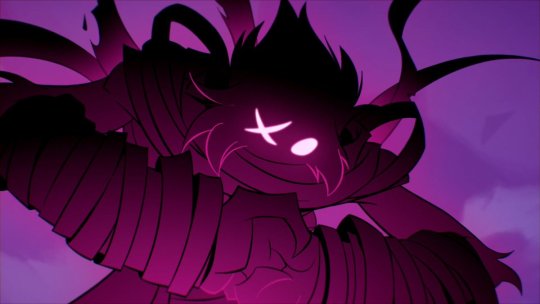
Following this definition, a 法相 is your true self, your essence, both physical and spiritual... meaning that Smokey (little guy) is not a 'kaiju'. It is an essence, Macaque's.
Same goes to all manifestations of characters who have a version of their 法相, it's their true essence.

Yes, you got it right! This little (not so little) guy is also a 法相.
(Don't call them 'kaiju', please).
Just to add, they can also be called 'war forms', since they appear in the original jttw.
#lego monkie kid#lmk macaque#lmk mk#lego monkie kid mk#fa3 xiang4#法相#lmk analysis#kinda?#smokey#mk's faxiang#macaque lmk#six eared macaque#going to eep after this#zzzzz
529 notes
·
View notes
Text

Heart Sutra ~ A sutra that describes “The Heart of the Perfection of Wisdom" (2)
The merits of “Prajna-paramita Hridhya Sutra” [So far]
The Heart Sutra, which is commonly circulated in Japan, was translated into Chinese from the original sanskrit by Xuanzang.
Xuanzang (6 April 602 – 5 February 664), born Chen Hui or Chen Yi, also known by his Sanskrit name Mokṣadeva, was a 7th-century Chinese Buddhist monk, scholar, traveler, and translator. He is known for the epoch-making contributions to Chinese Buddhism, the travelogue of his journey to India in 629–645, his efforts to bring at least 657 Indian texts to China, and his translations of some of these texts.
Not a few commentaries on the Heart Sutra emphasise its immeasurably great merits. It is quoted in part below:
'The Buddhist monk Xuanzang Dharma Master received this scripture and experienced an outstanding spiritual experience. This is why this scripture has been spread to the general public. Therefore, if you wear clean clothes, sit upright, and recite this scripture 500 times, you will be able to eliminate 95 kinds of evil ways, and if you live by following this scripture, you will be liberated from all suffering and troubles.’ It describes how Xuanzang received the spiritual power of the Heart Sutra.
In other commentaries, there are specific passages describing what the spiritual experiences of Xuanzang were. [To be continued]

般若心経 〜「智慧の完成」の精髄を述べる経典 (2)
『般若波羅蜜多心経 (梵: プラジュナーパーラミター・フリダヤ・スートラ) 』の功徳(これまで)
日本で一般的に流布している『般若心経』は、玄奘三蔵が原典のサンスクリット語から漢語に翻訳したものである。
玄奘三蔵法師(602年4月6日-664年2月5日)は、陳慧または陳毅の名で生まれ、サンスクリット名モクシャデーヴァとしても知られ、7世紀の中国の僧侶、学者、旅行者、翻訳者である。彼は、中国仏教への画期的な貢献、629 年から 645 年にかけてのインド旅行の旅行記、少なくとも 657 冊のインドの文献を中国に持ち込む取り組み、およびこれらの文献の一部の翻訳で知られている。
『般若心経』の注釈書の中には、その功徳が計り知れないほど多大であることを強調するものが少なくない。その一部は以下引用:
“玄奘三蔵法師はこの経典を受持されて優れた霊験を経験された。このことによってこの経典は一般に流布した。だから清潔な衣を着て正身端座して、この経典を五百回読通するならば、九十五種の邪道を除去することができ、またこの経典に随従して生活すれば一切の苦厄から解脱することができる。”
他の注釈書にも、玄奘三蔵が受けた『般若心経』の霊験がどのようなものであったかが、具体的に記されている箇所がある。[つづく]
#zen#mindfulness#buddhism#wisdom#philosophy#heart sutra#xuanzang#art#nature#spiritual power#silk road#merit#journey to india
74 notes
·
View notes
Text
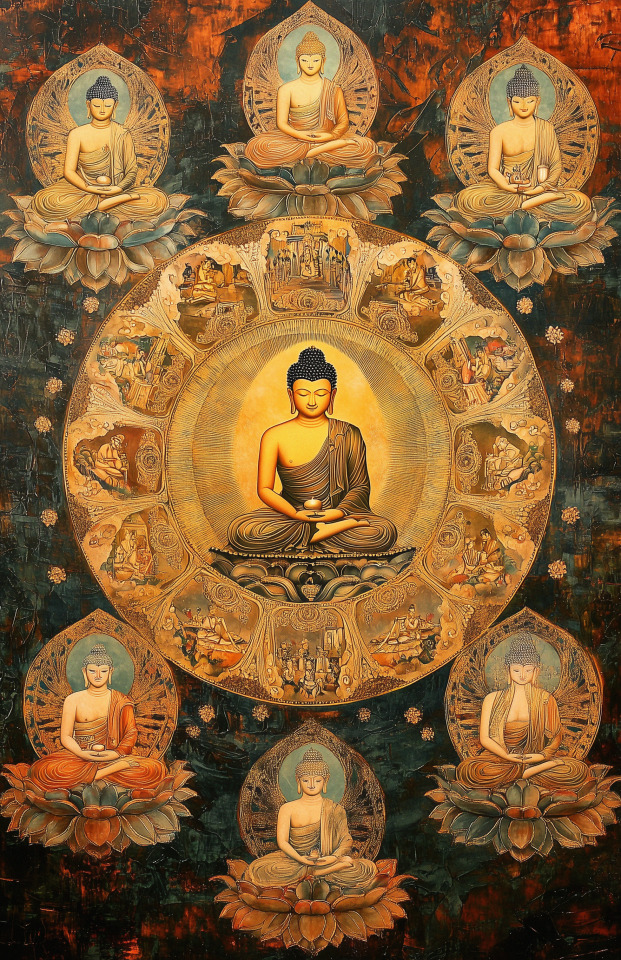
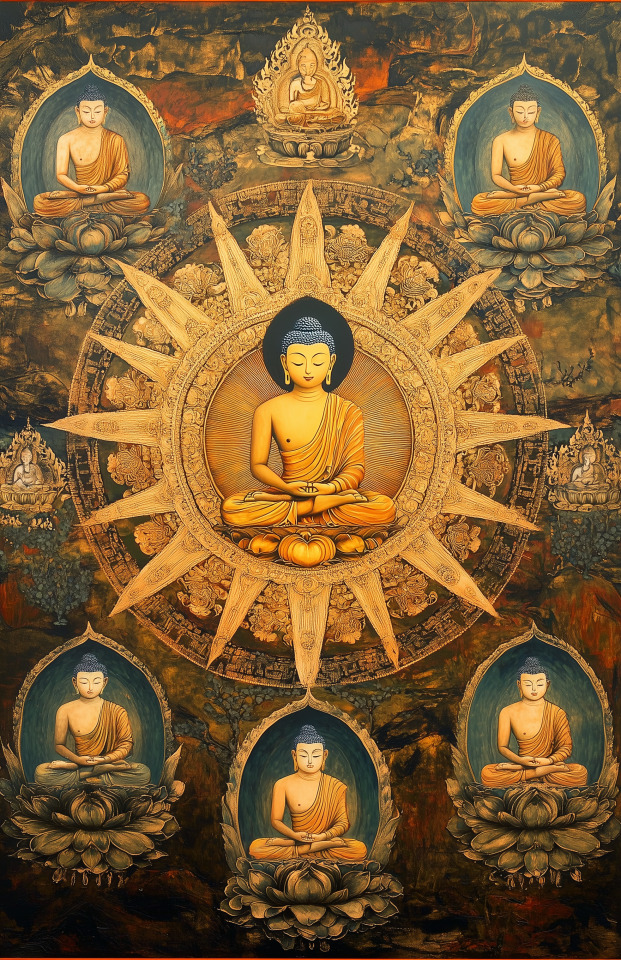
Vairocana | The Five Wisdom Buddhas Talon Abraxas
Not all Buddhas were considered flesh and blood or walked the earth. The Five Wisdom Buddhas are the Wisdom states as persons. The body of Vairocana is the body of the True Dharma.
The Five Wisdom Buddhas arose during the Mahayana development in India and were taken up by Tantric Buddhism. In Japan they appear in Shingon. These Buddhas differ from the Buddhas who appear in the lineage or who are said to have walked the earth at a certain time in a certain place as they represent principles of Mahayana teaching. They are sometimes called ‘Meditation Buddhas’ to distinguish them and because they may only be encountered in the states of meditation that form their bodies.
Vairocana is called the ‘Sun Buddha’ and is the ‘First’ (Skt. Adi) or ‘Primoridial’ Buddha and sits in the central place of the Five Wisdom Buddhas mandala surrounded by the four other Wisdom Buddhas who sit at the cardinal points. His name in Japanese is Dainichi Nyorai – The Buddha of Universal Illumination. His names and attributes are all connected with light and illumination, rays of life-giving power that initiate, nourish and sustain as the sun does all life on earth.
In Mahayana teaching his body is the Body of the Dharma (Skt. Dharmakaya), and is synonymous with such terms in Zen as ‘True Nature’, ‘True Face’ and ‘Buddha-nature’. His nature is emptiness (Skt. Sunyata), the ‘unborn’ of which the Buddha spoke in the Pali Canon, without which that which is born and created could not come into being.
Vairocana first appeared in the Brahmajala Sutra, a 5th Century manuscript written in Sanskrit and translated into Chinese by Kumarajiva. The title translates into English as Brahma’s Net Sutra. This relates to the analogy used by the Buddha who described a net that spreads throughout the universe in the three dimensions of space: length, breadth and depth. Where three strands meet there is a jewel to hold them in place like a dewy spider’s web. Each jewel reflects both itself and all the other jewels in the net simultaneously. The feel of this image is used to point towards the reality of emptiness, the true nature of the Dharmakaya – which is the body of Vairocana.
“Now, I, Vairocana Buddha, am sitting atop a lotus pedestal; on a thousand flowers surrounding me are a thousand Sakyamuni Buddhas. Each flower supports a hundred million worlds; in each world a Sakyamuni Buddha appears. All are seated beneath a Bodhi-tree, all simultaneously attain Buddhahood. All these innumerable Buddhas have Vairocana as their original body. “
-The Brahma’s Net Sutra
As the primordial principle Vairocana speaks outside the phenomenal world where all time is simultaneous. Although in the phenomenal world he has this or that name and is portrayed using this or that hand position (mudra), wearing certain garments and headdress, in truth he is beyond conceptual imagination and yet is ever present in each form, as Master Hakuin wrote: ‘‘like salt in seawater or glue in paint.”
In Shingon Buddhism he is represented by the Sanskrit letter ‘A’ which expresses life & death; emergence & return.
The mantra associated with Vairocana is:
Om a-vi-ra-hûm-kham vajradhâtu vam (Skt.) Om All Pervading One; Imperishable One
75 notes
·
View notes
Text
April 12, Xi'an, China, Daci'en Temple/大慈恩寺 and the Giant Wild Goose Pagoda/大雁塔 (Part 1 - Temple and Architecture):

Daci'en Temple is famous in popular culture mainly for one reason: the monk Xuanzang/玄奘, or the real person who inspired the character of Tang Sanzang/唐三藏 (sometimes translated as "Tripitaka") in the novel Journey to the West/西游记. Xuanzang was in charge of Daci'en Temple after he returned to China in 645 AD from his journey throughout Central Asia and India. More on him later.
The temple is also known for two more things, first is its importance to Chinese Buddhism, as the temple is considered the cradle of the Consciousness-Only School (weishizong/唯识宗) and the Dharma Characteristics School (faxiangzong/法相宗)(both are part of Chinese Mahayana Buddhism), and second is the Giant Wild Goose Pagoda (built in 652 AD while Xuanzang was in charge of the temple).
The temple has been rebuilt over the years, and the current temple (excluding the pagoda) was mainly built in 1466, during Ming dynasty, thus the current temple consists of Ming-era architecture:


Drum and bell towers within the temple


Giant Wild Goose Pagoda in the distance

More pictures of the architecture. I have to say it's better preserved here than in other places so far...





Coming up to the Mahavira Hall/大雄宝殿 of the temple

As mentioned in the previous posts on Qinglong Temple, I avoided taking pictures of the Buddha statues as this is considered disrespectful. But because it's just hard to avoid including them in pictures of the architecture, the statues may be partially visible sometimes.


Approaching the Tushita Hall/兜率

More pics of the architecture, note the pattern on the windows, called chuangling/窗棂. This particular one is a "three-crossing"/三交 pattern, the highest grade of chuangling.
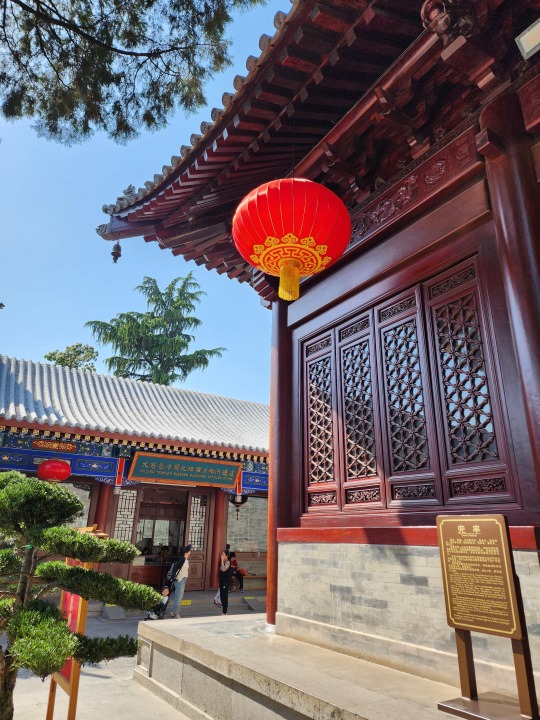

There were two visiting monks taking pictures of this relief behind Mahavira Hall, so it's probably okay to snap a picture of it. The interesting thing is the bian'e/匾�� above it, which says 人天欢喜 (right to left: "human and heaven rejoice together"). Usually it's "heaven" before "human" (天人), but here it's clearly "human" before "heaven".



The Guanyin Hall/观音殿. Guanyin is the Chinese name for Avalokitesvara. The smaller red lanterns are where visiters hang their wishes from:

And finally the Giant Wild Goose Pagoda, one of the landmarks of Xi'an. This pagoda was originally built to house all of the Buddhist texts and relics Xuanzang had brought back from India, and is the largest Tang-era brick pagoda remaining today. In Tang dynasty (618 - 907 AD), people who passed the imperial exams to become jinshi/进士 would tour around Chang'an on horseback with flowers in their hair and write poems before this pagoda, called "雁塔题名".
Before we entered the temple, I could hear a weird jingle-jangle from across the street, but it was only when we came up to the pagoda that I realized where the sound was coming from. There were bells hanging from every corner of every level of the pagoda, and they were pretty loud for their size.

Since it was pretty hot outside that day, to avoid possible heat stroke we didn't attempt to climb the pagoda (I don't think there's air conditioning inside considering that this pagoda is 1300+ years old.....). I think there were several important artifacts/relics inside? But I can find some pictures from online for part 3.



#2024 china#xi'an#china#daci'en temple#大慈恩寺#giant wild goose pagoda#大雁塔#xuanzang#玄奘#buddhist temple#chinese architecture#chinese history#mahayana buddhism#buddhism#architecture#history#culture
95 notes
·
View notes
Text
The Inconsistency of Nezha's Age, a Short Introduction.
Put very bluntly, Nezha’s age varies greatly depending on which story you’re reading and who’s retold it. He is not always a child or an adult depending on retelling, though my intention here is to highlight the sheer variety available first and foremost - and perhaps shine a light on the Indian dieties which may have influenced him. If these varied images are unwanted, please keep scrolling.
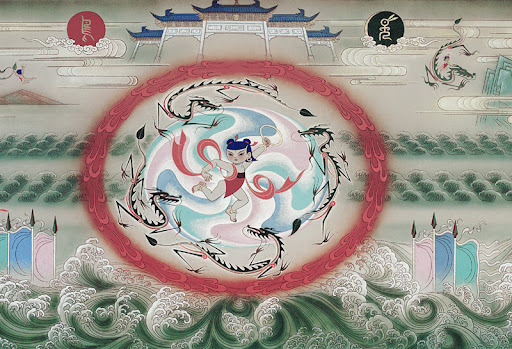
I happened to stumble upon a timeline error where Nezha’s brother Muzha is described to be using martial arts weapons referred to as “Hooks of Wu” which were specific to the 1800s, quite a long time after Canonization of the Gods was published, but also originating from a time period where numerous varied editions of that story were in circulation. Upwards of twenty different versions exclusive to the 19th century, actually.
The problem arises that Canonization of the Gods is meant to be occurring during the Zhou Shang conflict, that I will generously assume to be in 1045BCE, centuries before the Hooks of Wu would actually exist. It’s completely possible that the version Gu Zhizhong translated was one of these later editions as is makes no chronological sense for Muzha to have those kinds of weapons to begin with. So I have been on somewhat of a rabbit chase trying to pin down the edition Gu Zhizhong used.
Bearing such errors in mind, it’s easy to see where the confusion of Nezha’s age can come from. Before his origin story was integrated within Canonization of the Gods he would be roughly three to seven days old when his conflict with Ao Guang and the Lady Rock Demoness would occur - whereas within Canonization of the Gods he’s actually 6 or 7 years old.
Outside of that, a definitive age isn’t actually provided. Genuinely, within the scope of Chinese folklore and mythos it’s very rare to assign someone an exact age - which I do believe contributed heavily to the known discourse surrounding Nezha’s age to begin with.
He was imported as an adult from India, a child form not seeming to exist for a while until stories of Krsna were integrated to how the Chinese envisioned Nalakubara. Krsna, being an infantile disguise for the notorious Vishnu, also displays supernatural human strength and is actually successful in killing his father figure (1) — unlike Nezha.
As children, both Krsna and Nezha are able to wield heavenly bows and subjugate water spirits (2) while also being known to be dragon tamers (3). The inclusion of these stories to Nezha predates the sculpting of the Quanzhou Pagoda’s (which have been discussed briefly here) and are arguably the earliest evidence of Nezha being a dragon tamer.
Speculatively a child god combination of both Nalakubara and Krsna named Nana is likely where a majority of Nezha’s child attributes come from, based in the Scripture of the Supreme Secrets of Nana Deva - which would see translations within China during the Northern Song period of 960AD-1127AD. Nana would be described thus:
At that time there was a Deva called Nana. His appearance was exceptionally handsome, and his face beamed with a gentle smile. He was holding the sun, the moon, and various weapons. His numerous treasures and abundant jewelry shone more brightly than the sun and the moon. He made himself a luoye robe (4) from the dragons Nanda and Upananda, and a belt from the dragon Taksaka (5). He possessed the same strength as Narayana (i.e. Visnu). He too came to the assembly and sat down facing the Buddha … At that time the Buddha emanated great light from his dharma body of meditation. The light covered the entire Buddha Universe, reaching all the great evil yaksas, the various types of raksasas and pisacas (6) and all the evil dragons as far as the heavenly constellations. When the Buddhas light shone upon them they all awoke to the truth. The Buddhas light returned to him and, after encircling him three times, entered his head. It then reissued in seven colors from his brow, entering Nana-Deva’s head. When the Buddha light penetrated his head, Nana Deva displayed an enormous body like Mt. Sumeru. His facial expression alternated between terrifying anger and a broad smile. He had a thousand arms, and he was holding a skull (7) and numerous weapons. He was handsomely adorned with a tiger skin robe and skulls. [Mightily Strong] He emanated blazing light and terrifying strength. When Nana Deva displayed this divine body, the great earth shook, and all who beheld him were terrified.
Both Nana and Nezha share the same residence of Vaisravana’s palace, are known dragon tamers, and both were known to use belts. The Supreme Secrets of Nana Deva predate all known connections between Nezha and dragons, perhaps lending to Nezha many more elements than initially believed.
Though without concrete evidence stating one way or another, I can only present this information speculatively - especially as it seems difficult for some to understand that Nezha does enjoy a known adult and child form. This answer has already become quite long, so if there’s still confusion regarding this please feel free to ask for more details.
Bibliography:
(1) Goldman, “Fathers, Sons and Gurus,” pp.350, 364; Masson, “Childhood of Krsna”; Ramanujan, “The Indian ‘Oedipus’”; Silk, Riven by Lust, pp. 164-170.
(2) Harley, “Krishna’s Cosmic Victories”; Matchett, “Taming of Kaliya”.
(3) It’s worth comparing Matchett’s “Taming of Kaliya” p.116 with Canonization of the Gods 12.103. Nezha is five days old within the Ming era Sanjiao yuanliu shengdi fozu sou shen daquan, p. 326.
(4) Luoye is the Chinese term for a garment Indian men tied under the armpit, leaving their right shoulder bare. See Xuanzang, Da Tang Xiyu ji, T. 2087, 51: 876b, and Li Rongxi’s translation, Great Tang Dynasty Record, p.53.
(5) Nanda, Upananda, and Taksaka appear in various Buddhist lists of the eight dragon kings; see Foguang da cidian, pp. 6378,6405.
(6) The rakasas and pisacas are two types of Hindu ogres, who Buddhists demonology incorporated. Both types feed on human flesh. See Foguang da cidian, pp6673-6674 and 3851; Monier-Williams, A Sanskrit-English dictionary, pp. 871 and 628; and Strickman’s survey of Buddhist demonology in his Chinese Magical Medicine, pp. 62-68.
(7) Geboluo appears frequently within the contemporaneous Chinese translation of the Hevajra Tantra (Foshuo dabeikong zhi jin’guang dajiaowang yigui jing), no. 892 volume 18: 587-601.
(8) Zuishang mimi Nana tian jing, no. 1288, 21:358b-c. hi
#nezha#li nezha#lmk nezha#monkie kid nezha#the legend of nezha#nezha 2019#nezha reborn#nezha lego monkie kid#third lotus prince#lego monkie kid
260 notes
·
View notes
Note
Can you please tell me what abilities sun wukong have because am always confused about it i even hear some people says that sun wukong is omniscient and omnipresent and can control time or that he is is a boundless character
At no point in JTTW is Monkey ever depicted as a boundless character with omniscience, omnipresence, and control over time. Anyone claiming that has never read the novel. Never ever trust any online claims about Sun Wukong unless a cited quote is provided.
Having said that, I am slowly compiling a comprehensive list of all of Monkey's magical abilities and skills, complete with corresponding Chinese terms and citations. However, I am nowhere close to being done (and won't be for years), so I can only give you a general list at this time. But I will link to my past articles where applicable.
The following is based on a list I wrote a few months ago for someone looking to make their D&D campaign more authentic.
Immortality - He has six layers of immortality. But these are more like layers of invulnerability. As a "bogus immortal" (yaoxian, 妖仙) he is still susceptible to injury and death because he hasn’t yet achieved Buddha-nature and broken free of the wheel of rebirth (see note #1 here for an explanation).
Invulnerability - He has an adamantine hide that can't be pierced or hurt by earthly or heavenly weapons and elements (this doesn't count the times that he allows himself to be cut). This is thanks to all of the immortal foodstuff he had eaten in heaven being refined within his body by his samadhi fire, giving him a "diamond body" (jingang zhi qu, 金鋼之軀). Sometimes he uses this invulnerability to freak out demons by blocking a sword strike with his bald head. However, he can still be hurt. For example, he is twice wounded by special elements born from spiritual cultivation, samadhi fire and wind (the book treats cultivated and heavenly elements as two different things). Also, one villain, a scorpion demoness energized with Buddhist dharma power, is able to successfully penetrate his skin by stinging him in the face with her tail.
72 changes - He can transform into anything. The only flaw is his tail, which doesn't always change the way he wants it to. Or, a character recognizes him because of his red butt.
Cloud somersault - This allows him to fly 108,000 li (33,554 mi / 54,000 km) in a single leap. The skill is actually a metaphor for instantaneous enlightenment, for those who achieve it will immediately arrive in the Buddha's paradise.
Magic hairs - He can change any one of his 84,000 hairs into anything he wants (tools, random objects, living creatures, etc.) These include hair clones, which are autonomous copies of himself that can range into the tens, hundreds, thousands, millions, or even billions. However, he only deploys these on a small scale in the novel. He never uses the power to its full stated extent.
Super strength - His greatest feat is carrying two mountains while running "with the speed of a meteor." But there are characters physically stronger than him. For instance, Monkey cannot escape the grip of the Great Peng bird once he is caught in his powerful talons.
Martial arts - He is proficient in armed and unarmed combat, being able to go toe-to-toe with deities with centuries more combat experience than him. "Short Fist," a historical style, is listed as his preferred boxing method. But he mainly relies on his magic iron staff for fighting.
General magic - Monkey is shown capable of calling forth gods and spirits, growing or shrinking to any size, parting fire and water, creating impassable barriers, conjuring wind storms, casting illusions, freezing people in place, putting anyone to sleep, unlocking any lock, bestowing superhuman strength, bringing the dead back to life, turning invisible, changing someone's appearance, traveling to and from heaven and hell, etc.
Magic Eyes - He can see through illusions. But this isn't always portrayed consistently, for I know of several times where Guanyin fools him, and even a god of the soil, a lesser deity, is once able to do the same thing.
Medicine - He can diagnose maladies and concoct medicines to solve the issue.
You can see that omniscience, omnipresence, and control over time are not listed. I think the problem is that people are confusing Sun Wukong at two different points in his character arc. The powers listed above come from the journey itself (ch. 13 to 100). The omni-level powers would come after he achieves Buddhahood at the end of the novel (ch. 100). However, it's very, very important to know that the story ends before Sun Wukong, now the "Victorious Fighting Buddha," performs any feats (i.e. he has no feats as a Buddha). I'm sure people could assign him powers ascribed to other Buddhas in religious literature, but what happens after the story ends is beyond canon.
I hope this helps.

#Sun Wukong#Monkey King#Journey to the West#JTTW#monkey buddha#Victorious Fighting Buddha#Buddha Victorious in Strife#magic powers#People who make spurious claims about Sun Wukong need to read the fucking novel!!!#Read the fucking novel!!!#Do it!!!#Just do it!!!#Lego Monkie Kid#LMK
174 notes
·
View notes
Note
Hello! Big fan of your Erlang Shen posts 😍 Gimme more. I’m curious—what’s the deal with his third eye? Not gonna lie, as beautiful as he is in the game, it was his third eye that really drew me in. I’ve heard it’s called the “Eye of Heaven,” so is it a rare ability? Is that what makes him so powerful, like more powerful than the other deities? What's the history behind it? What can it do exactly?
Thank you! Really glad you're enjoying the read 😊
That's a fantastic question, and, as always with Erlang, the answer is more complicated than it seems 😂 In short, Erlang didn't actually have a third eye until the Qing Dynasty (1644-1912), so he's without the "eye of heaven" in both JTTW and Investiture of the Gods. Quite counterintuitive, right? It feels like he uses associated powers in both stories—and that impression isn't wrong.
Erlang Shen has always been famed for his instinctual ability to see through illusions and trickery. In JTTW, this perceptive power is on full display during the OG duel between him and Sun Wukong. Besides being a skilled shapeshifter himself, Erlang's sharp perception allows him to consistently see through Wukong's transformation, giving him an upper hand as he adapts his tactics in response to Wukong's. Only Guanyin, the bodhisattva, possesses a similar "wisdom eye" with the aid of her vase and lotus. It's pretty cool that Black Myth: Wukong pays homage to this legendary detail, having Erlang counter the Destined One's transformation and provide specific comments on each transformation choice.
In Investiture of the Gods, Erlang’s perceptive ability is depicted as an extraordinary capacity to see through complex illusions and schemes. Unlike many other characters who rely on magical artifacts or spells, Erlang’s vision appears to be an innate “divine insight” (or just him being a smart ass) that allows him to detect hidden truths and reveal the true forms of both enemies and allies alike. Even without a third eye, Erlang’s perceptive prowess aligns him with selected higher-ranking immortals, giving him a tactical edge that reflects his reputation as a discerning and formidable deity in Chinese mythology.
These stories frame Erlang's special vision through the lens of Buddhism and Daoism, both of which contributed to the semi-canonization of his third eye in later centuries. However, Erlang's perceptive prowess predates those interpretations and can be seen in oral traditions and folk operas. This ability of his likely originated from the eye-worship traditions in Sichuan's folk belief system, a theme evident in Bronze Age artifacts and chorography records dating back to the 4th century. In Sichuan's local traditions, special eyes are associated with omniscience and authority, qualities fitting for Erlang as the chief god of the region.
How Erlang gained an actual third "eye of heaven" is another multi-layered story. It involves Daoism, Buddhism, Hinduism, the rise of three-eyed Dharma protectors during the Ming Dynasty, and the geo-temporal overlap of ritual practices linking Erlang to one such deity. Since Erlang already possessed extraordinary perceptiveness, adding a third eye to his visual representation seemed to make perfect sense and thus became a permanent feature in popular imagery over the last century or two.
I could expand the last two paragraphs into separate posts for more depth, but I hope this covers most of your questions without going too far down the rabbit hole!
#erlang shen#third eye#journey to the west#sun wukong#black myth wukong#investiture of the gods#yang jian#chinese folk religion#chinese mythology#chinese literature
52 notes
·
View notes
Note
Do you have any headcanons for Raimundo and Master Fung's necklaces in Xiaolin Showdown? Where did they acquire them, who did they get them from, how long have they had them, what do the necklaces mean to them personally, do they fidget with them a lot, stuff like that?
I do have one for Raimundo’s necklace, the medallion is from his grandpa, he acquired it when is very little when he was a baby his grandpa use it to dangle it around his face to play with him and Rai even uses it for teething eventually Grandpa just gives him the damn thing because he loves it so much when Rai gets older he thought it’s something very valuable from his grandfather (an actual medallion from his army) and he cherishes it, when he was 10 he accidentally throws it into a laundry pile with his clothing, he thought he lost it, usually he is very careful about this would take the necklace off before taking off his clothes. He searched everywhere and later confessed to his grandfather that he lost it but he just laughed and laughed, he said it was a souvenir from a street stand as if he would give his actual medallions to a baby, but tell him maybe after he passed away he will put a real one in the will to him. Later his mom found him and told him that she found it in the washing machine. And he still loves the damn thing even though it has no real money value in it.
Master Fu I don’t have any headcanon, since you ask I can think of some possibility of why he has it Master Fung, “Fung” is his surname 方 Fong and 仁 REN is the word on his necklace, and this is my headcanon that 仁 is his “Dharma name” (is the name given to those who convert to Buddhism. After the monks become ordained, the name given by the master to each disciple who becomes a monk. information from google) And a Dharma name usually chooses to wish the disciples to work towards the virtue the word represents or a virtue they already has and hope they will remember it and hold onto it no matter how hard the life become, and Ren 仁 means Benevolence, I like to think master Fung has it custom-made in the tourist gift shop Chinese first name Keychain section, I don’t know if it’s the same in China but in my country Taiwan you can see the surname name chains in every tourist spot, and 仁 is a rare name so he has it custom-made in the gift shop down the hills from the temple, I headcanon the Xiaolin temple mountain is located in a national site seeing tourists spots and has a nice little town 3 hours walk from it. Or Master Fung’s master has it made for him.
This is a pretty long answer thank you for reading all this.
23 notes
·
View notes
Note
What are monks and what do they do?
are they religious leaders like priest or are they schoolers or something else?
How did someone become a monk in ancient times? Was it a boys only position? Could just anybody become a monk or did you have to do something or be something to qualify?
By monk, I assume you mean "Buddhist monks"?
Well, they are members of the Sangha, one of the "Three Jewels" (三宝) of Buddhism, which consists of the Buddha, the Dharma (Buddhist Teachings), and the Monastic Community.
(Once again, I can only talk about Mahayana Buddhist monks in imperial China. If you want more info, I recommend talking to an actual Buddhist.)
Usually, when we say "monk" (僧/和尚), we don't just mean "adherents of the Buddhist religion", since you can offer incense at a temple, copy sutras, or have a statue of Bodhisattva Guan Yin on your private altar without becoming a monk.
These are people who 1) have gone through the relevant ordination rites and swear to abide by a set of religious vows, and 2) are part of a monastic community.
In other words, they are "cloistered" (出家人), leaving their home to learn and practice their religion in a temple, as opposed to lay practitioners (在家人) who carry out their religious activities in daily life.
And no, it's not a boy-only position——there are plenty of Buddhist nuns (比丘尼/尼姑) too.
Officially, to become a monk, you need to leave your worldly life behind. Which means, if your parents are still alive, you need to get their permission, if you are a court official, you need to quit your job, and if you are married, well, you cannot remain married.
Also, living in a monastic community means you were no longer considered viable for conscripted labor or taxation, and temples owned private lands, the increase of which could, well, depriving the imperial court of available land.
(This is one main motivation for historical prosecutions of Buddhism by certain emperors: the seizing of temple property + returning the monks and nuns back into the taxable population.)
As such, the imperial court tended to keep a firm control on the number of monks and the size of the temple. Basically, you need an official permit (度牒) from the state too, given out to each temple by the officials, and the monks didn't have the authority to make you one of their own in private.
Those who have committed one of the five grave crimes——killing their father, killing their mother, killing an arhat, destroying the unity of the monastic community, and "wounding the Buddha"——cannot become a monk either.
The most visible change one must make is shaving their head, like, entirely bald.
Those above the age of 7 but under 20 can become monks-in-training, called 沙弥/沙弥尼, but not formal member of the clergy because they are still considered too young to endure the physical and mental hardships.
(Similarly, adults who seek to become a formal monk must also pass through this training stage first.)
An aspiring monk, after receiving his permit, must first find a respectable monk, answer a series of questions that assess his fitness for monastic life, pay his respect to the Buddha and the monks of the temple he's joining, then becomes the disciple of one of those monks.
One monk will shave his head and bath him, while his master clothes him in his monk robes. Then, on the next day, he will receive his ordinations inside a temple hall, in front of the entire community, where he recites the monastic percepts (read: rules a monk must follow) and agrees to abide by them.
At this point, he has become a monk-in-training, which is a prerequiste stage for formal monk ordination, 比丘戒.
Usually, the latter ceremony is carried out at an actual altar, and the candidate must have already bought the "six necessasities" of monkhood ——three sets of robes, almsbowl, sitting cushion, and water container.
In Chinese Buddhism post-Yuan dynasty, the ordination rites may also include using burning incense sticks to leave a bunch of little marks (usually 12) onto one's head.
(Source: 《中国古代僧人生活》)
30 notes
·
View notes
Text
Religious Imageries in JJK: The Conflicting Views of Shinto and Buddhism.
Disclaimer: This is not an explanation post, this is an observer post. I will try to sum up what I have observed so far.
Let's begin with the definition and history of both Shinto and Buddhism.
Shinto [神道]: Combined with the kanji of God/Kami (神) and Road /Michi(道), Shinto literally means The way of the God(s). It is the indigenous religion of Japan and is as old as Japan itself.
Shinto belief is polytheist and animistic as it has almost 8 million gods that are derived from nature and natural things. This religion revolves around "Kami". Kami can be manifested from anything, but the most important Kami are the natural ones.
Sun, Rain, Earth etc. The most important central Kami is Amaterasu the Kami of the Sun. The exact history of Shinto is untraceable but it was mentioned in the Yayoi Period (300 BCE to 300 CE) of text.
Shinto describes the world as a inhabitant of the human and the kami they worship. It describes the world as founded by the kami and once humans/ living beings pass away they become kami as well.
It is safe to say that Shinto belief described humanity as living being as a whole, where even after death they don't living. The idea of morality or immorality is also absent from it. The existence of Kami is the manifestation of humanity itself and not separated from human beings.
Fun Fact: Chinese indigenous religion 'Dao' has the same characters as Shinto's kanji. So it might be possible that Shinto actually comes from Chinese Daoism.
Buddhism: Buddhism is an Indian religion. It revolves around the teaching of Buddha. Buddha is no myth. Even though convoluted, early texts gives his name as "Gautama" and he lived around 5th to 6th Century BCE.
In India his name is mostly known as "Siddharth". He was born in Lumbini in present day Nepal and grew up in Kapilavastu. The border of India and Nepal, a town of the Ganges plain of present day Bihar and Uttar Pradesh.
The most notable person who helped spread Buddhism around India so much that it was spread in the NEA and SEA is Emperor Asoka (304-232 BCE) from the Maurya Empire (322-180 BCE).
Buddhism circles around the suffering of human, the circle of life and Karma (deed). Where a soul is constant as it is being born in this world as human, it goes through the cycle of life (suffering) and it dies.
It also talks about Dharma as the ultimate truths, also that humans are born to fulfill a certain role. Moksha: The liberation from the earthly desire which should be the ultimate goal of a human being.
It also draws the line between God and humans as Gods are separated from the earthly matters and pushes the idea of Gods creating the universe and the creating the humanity.
The Mix of both Religion:
Though the idea of Shinto and Buddhism is pretty contradicting it existed with each other for centuries.
Even though Buddhism entered in japan in Yayoi Period (250-538 AD), it became popular in Asuka Period (538-710) due to buddhist sect taking the rein of the country. Initially Buddhism and Shinto coexisted and even mixed with each other. It was called Shinbutsu-Shougou. However, later it was forcefully separated by Japanese nationalists in Meiji Era (1868-1912) and Shinto became the state religion of Japan with the Emperor being worshipped as Kami the descendants of Amaterasu.
Cursed Spirit: The reason I am writing this is not because the obvious depiction of buddha, Buddhist shrines and mention of clans and sects etc. What caught my interest was that the idea of "Cursed Spirit".
The textbook explanation of Cursed Spirit is that the reaction of human emotions but as we see it is actually the manifestation of human existence. As long as humans will exist, curses will also exist.
Which pretty much resembles the idea of Kami.
The timeline: The golden era of jujutsu was Heian Era which historically existed between 794-1185 AD. Almost a century after Buddhism was introduced in Japan. Also in that era Sukuna rose up as the king of curses. Which may indicate the clans existed even before and Sukuna existed throughout.
Characters like Kenjaku and Tengen their birth and living timeline are unknown but they might just as be as old as Japan, like Shinto.
Getou and Megumi are the only two people who can control curses as Shikigami. Which is another japanese Shinto belief that has also been associated with "Curses" during Heian Era.
The people who used to control Shikigami were called Onmyoji (Yin-Yang Master).
Both of them were either antagonised or villfied by the jujutsu society at one point.
Also the most important part that made me think about this is...Sukuna's domain.

This resembles an average Shinto shrine...

The Tori is missing.
Insanity.
Anyways. I am not saying that Gege is making one religion look bad and another look good. It's not true and actually far from it. Though contradiction, Gege shows the good and bad of both sides. Kenjaku is bad and the higher ups are as worse as him.
Personally I think this is a battle of belief of the world with a main character emerges with no beliefs at all. Itadori Yuuji hates Sukuna but not by the virtue of being Gojo's student but his own opinion about him. In the latest chapter he says "Human beings are not a tool, so nobody's existence is premediated." Which contradicts the idea of "Dharma".
The message might be "If you want to change the world, you have to diverge from the existing path and forge your own."
24 notes
·
View notes